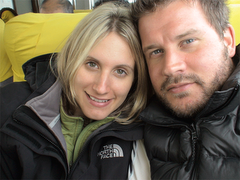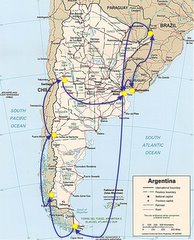We arrived into harbour at Port Stanley, Falkland Islands. First impressions were a pretty little town – a patchwork of bright colours on an otherwise barren but unremarkable landscape. The harbour plays host to many exposed wrecks including the Lady Elizabeth, there for all visiting ships to see and testament to the unpredictable and fierce nature of the islands’ weather systems.
Our only issue was that the winds had picked up. At the time we launched in the zodiacs it was 20 knots creating a large swell and breaking waves. This ordinarily would have prevented a launch. However, given that the risk was much more manageable with a dry landing at Stanley we proceeded. This turned out to be an exhilarating if wet and windy first zodiac experience!
From Stanley we travelled to Gypsy Cove; beautiful white beaches, turquoise waters – but bloody windy! All around are stark reminders of the 1982 Falklands conflict – beaches are fenced off due to the presence of unexploded landmines left by the Argentine forces. Amidst this though resides Stanley’s resident Magellanic Penguin colony.
We decided to walk back from the Cove to Stanley. However the winds by this point had picked up to 50 knots gusting much higher. The 5 mile walk back to Stanley felt much longer as a result! It is true that you will experience all seasons in one day in the Falklands, from sunshine gale force winds, ice and rain. Stanley brought some welcome respite when we finally arrived a good one and a half hours later.
Stanley is a strange but interesting place. It has its bank, its post office 9 small pubs, a couple of other government buildings and its brightly painted houses. That’s about it. But there is a lot of history attached to the islands (beyond the 1982 Falklands conflict) and the local museum gives a great insight.
3,000 people live in the Falklands – 2,000 in Stanley and the other 1,000 farming across both the west and east islands or living out at ‘Camp’ as the islanders describe it.
Stanley’s population nearly swelled by 100 when we visited though; the winds continued to batter Stanley all day and there was a strong risk that we wouldn’t be able to get back to the Vavilov by zodiac.
The Upland Goose Hotel provided the impromptu dinner venue; the hotel was made famous during the 1982 conflict as the location for all reporting correspondents and for the visiting Margaret Thatcher.
Fortunately the winds eventually dropped sufficiently to enable us to get back to the Vavilov and the opportunity was taken straight away (although the 1-2m swell made leaving the zodiacs onto the gangway of the Vavilov an interesting experience!).
On board we found out that while the ship had been bunkered in Stanley for the bulk refuelling required for the rest of the voyage the winds had hit 57 knots – a force 11 storm.









Excerpt from Peregrine website:
We arrive in the Falklands overnight and make our first shore excursion in the morning. Depending on conditions, we’ll explore the islands of the West Falkland Archipelago including West Point, Carcass or Saunders Islands, all rich in wildlife. We’ll find an abundance of land and seabirds with many migratory species in residence, such as the wandering albatross and its smaller relative the black-browed albatross.
We arrive in the Falklands overnight and make our first shore excursion in the morning. Depending on conditions, we’ll explore the islands of the West Falkland Archipelago including West Point, Carcass or Saunders Islands, all rich in wildlife. We’ll find an abundance of land and seabirds with many migratory species in residence, such as the wandering albatross and its smaller relative the black-browed albatross.
The breathtaking cliffs at West Point are home to busy rookeries of rockhopper penguins and Magellanic penguins nest in the tall tussock grass on privately owned Carcass Island, where we may see a variety of land birds. Here, we’ll also hope to observe oyster catchers, geese and the endemic steamer duck along the rocky shores.





